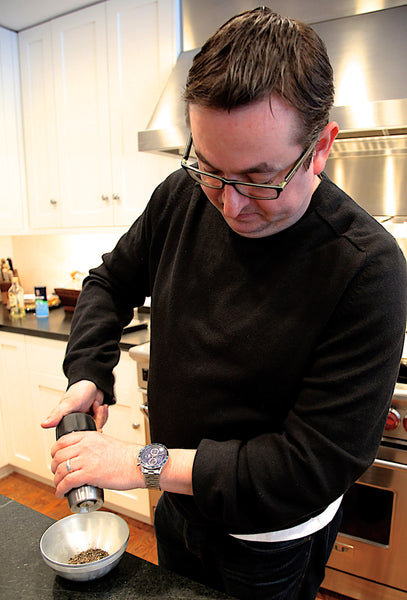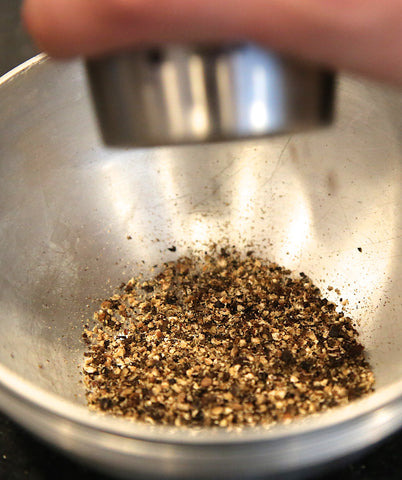Your Cart is Empty (Time to go shopping!)
This is the third part of a five part post with award winning Chef Todd Stein. The final post will detail the complete recipe and directions for cooking Chef Stein's version of Cacio e Pepe.
of Cacio e Pepe.
In a bit, we’re going to toast the pepper and then add it to the pasta, the butter and the olive oil. So I’m going to grind it now.
Todd begins grinding the pepper into a bowl. He then asks me for kosher salt to add to the boiling pasta water. The pepper immediately begins to open up. The fruit forward aroma of the Tellicherry pepper fills the air.
Oh my. That smells so good. It’s ridiculously good. It reminds me of…remember the blue raspberry popsicles? Popsicle brand popsicles? It had that really fruity smell to it? That’s what this reminds me of!
Yes, I was living in France. My sister and her husband were living in Bologna, Italy at the time. That was 1995.
I went for a month with Kendall College. And then I stayed for four months after that and worked at a bakery. So I got to go to Italy quite a bit to see my sister. You've heard about college students and kids going to Europe, whether they backpack through it or cook, whatever it is that they do, and it changes their life? In my case, it really did. At a young age in my early 20s, and also as a young culinarian, it really changed my thought on things. It’s funny, being back in Paris, this year for the first time since I was there and having a completely different appreciation, and obviously a much larger pocketbook, it was a really unique experience.
A few days here and there or five days here and there over that time. Probably a total of 13 days or so. But I knew the first time I went. I knew that was it for me.

Bologna, Florence, Tuscany, those areas, generally. I didn’t go to Venice or Rome.
I look at France, culinary-wise, much more like building a model. And then you go to Italy, and it’s even more so about ingredients and the neighborhood that you’re in, but in a much more rustic kind of way. That’s what appealed to me. It was taking these ingredients and doing very little to them and letting them speak for themselves. Here’s a piece of grilled radicchio with olive oil and a squeeze of lemon. That kind of stuff. I think being in Italy at that time shaped the way I cook, even though I didn’t initially always cook Italian food. It was that sensibility of how to treat ingredients and letting them be.
It was from talking to people, seeing the food, and then bringing it back and talking to the chefs that I worked for here in the States. Obviously, in the time that I was growing up as a cook in the early 90s, everything was very French influenced, not saying I was cooking French food, but that French method or technique was the basis.
There was no Thomas Keller cooking the way there is now. Jean Georges was really at the beginning of it with juices and simple reductions and things like that, but that wasn’t the base of how everybody cooks like they do now. Obviously, that was way before molecular gastronomy, but with natural reductions and keeping things simple. So for me it was taking those French techniques but using Italian ingredients.

I don’t think you can go with simple. Like if I were just to put out a plate of grilled radicchio with olive oil, nobody would buy it because it needs to be a component to a dish. I think the thing about Italy is that it’s a few things and that’s it. I think that we as Americans expect a large portion and or multiple things on the plate. Great American chefs that cook Italian food, it’s based on the tradition, but it’s twisted to the American palate and brain. You can’t just serve a steak here with olive oil and sea salt. People want something with it.
You’ve got to cook for where you are, the city you’re in and the dining room in which you're cooking. I think it’s taking common American ingredients and using that thought process. Everything in Italy is about what’s in your backyard. So if my backyard has “x” mushroom or these mushrooms are available to me, I’m going to use those. It doesn’t have to be a porcini because that’s what grows in Italy. I might do the same thing and use a shiitake because that’s what’s available to me. That’s how I’ve always looked at it. Whatever it is that I’m cooking, Italian food, French food, it’s what’s available at the moment.
I’m not going to do a dish in the winter and use frozen peas. I’m going to wait until the spring and use them. That’s not to knock chefs that do that for a dish that traditionally has peas in it, well great, then cook it in the spring, but don’t cook it now.
That’ll be interesting. It’ll be Georgia. Maybe a little bit of Florida. The great thing about Georgia is that there’s a lot of great fish. A lot of great produce that’s available and that’s grown in that area that I’m learning about, but it’ll still be that same technique and thought process.
No. For the first time in a long time, I won’t be cooking Italian and I’m actually really excited about it. It’s a lot of roasted meats. The grill in my restaurant has a three level rotisserie above it. The kitchen sits in the middle of the dining room. It’s a very boisterous restaurant. Saturday night it’ll do 800 to 1,000 people. A lot of small plates, a lot of meat, energetic and exciting. It’s in a giant warehouse that you would never know is there. It’s unlike anything you’ve ever seen and then you walk into this energy. There will be Italian twists, of course, because that’s generally how I cook because it’s in my DNA. I just have to disguise it as something a little different.

Just once. Last year. We went back to the bakery where I used to work. My wife said to me that she would've been lost without me on this trip because she doesn’t speak French. My French came back. But even after being gone for so long, we’d be in an area and I’m like this place is right around the corner and it was. Because it (Europe) doesn’t change as much. A store that was there 15 or 20 years ago is still there. It’s crazy. But going back as an adult, as a chef as opposed to a cook with the ability to experience it at a different price level? Totally different, yet still the same.
Obviously, the nose gives it all. That’s the key to this pepper. That’s the flavor. As a pepper, it’s not overly peppery and spicy. It’s got the natural pepper characteristics, but that fruit forward smell and flavor is what’s so great. I was cooking dinner Saturday night and I grabbed my pepper mill and every time I do it’s like, there we are! And I think that’s what’s so special about it. I think it can and should be used every day.
This coarseness (medium) is where you can best experience it. No, you’re not going to eat a salad generally with cracked pepper like that, but you might. I think that’s where it’s at its best. It’s exactly like coffee. It’s different when you grind it to different coarseness.
Yes. I think it’s great on a piece of meat. But when you grill a piece of meat, you’re going to lose a lot of natural flavor that (the pepper) has if you put the pepper on before you cook the meat. So sometimes I’ve used the pepper as a finish. Sprinkle it over the meat after its cooked. In long cooked braises it doesn’t really make sense. Salmon au Poivre would be great. It’s just good in so many different dishes. I hate to say don’t use it on this or that or use it on this or that. Just use it.
Now check out Part 4, "Now We're Cooking" where we finally get down to making Cacio e Pepe. Actually, Todd gets down to cooking, while I crack jokes and document the experience. You'll see how Chef Stein was able to take a few simple ingredients and turn them into something worth blogging about. In the end, I'll publish Todd's version of Cacio e Pepe and how you can make it at home yourself.
Cooking with Chef Stein • Part 4 • Now We're Cooking
Cooking with Chef Stein • Part 5 • The Recipe
Cooking with Chef Stein • Part 1 • I'm Not Worthy
Cooking with Chef Stein • Part 2 • Lost in the Supermarket
Like this post? Sign up for The Reluctant Trading Newsletter to keep up with the latest.